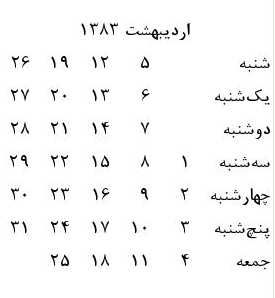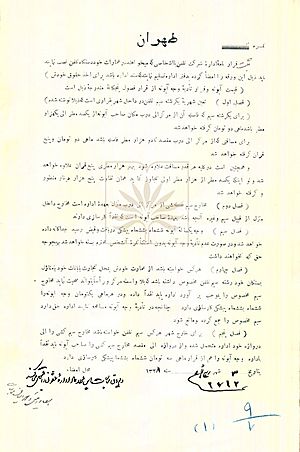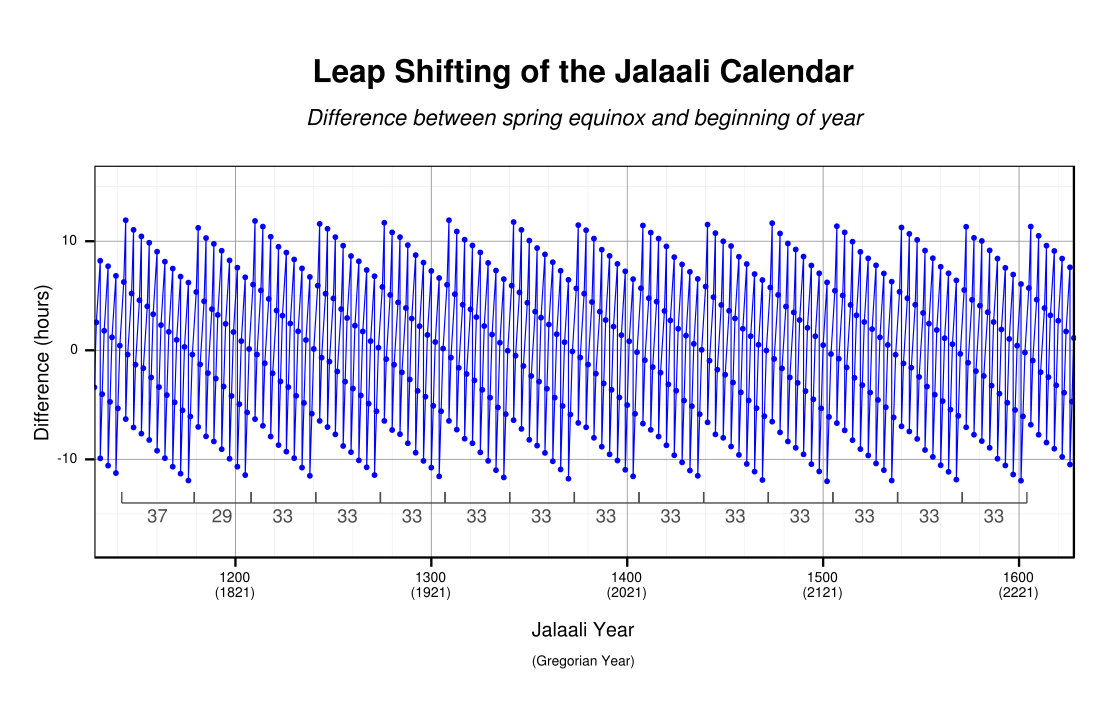Solar Hijri calendar facts for kids
Quick facts for kids Today |
|
|---|---|
| Monday | |
| Gregorian calendar | September 1, 2025 |
| Islamic calendar | 8 Rabi' al-awwal, 1447 AH |
| Hebrew calendar | 8 Elul, AM 5785 |
| Coptic calendar | Mesori 26, 1741 AM |
| Solar Hijri calendar | 10 Shahrivar, 1404 SH |
| Bengali calendar | Bhadro 18 BS |
| Julian calendar | 19 August 2025
[] |
The Solar Hijri calendar is the official calendar used in Iran. It's a solar calendar, which means it's based on how the Earth travels around the Sun. Each year starts on the first day of spring, called the March equinox, and has either 365 or 366 days. You might also hear it called the Shamsi calendar or Persian calendar. It's often shortened to SH.
The very first day of this calendar was March 19, 622 CE. This year is important because it's when Mohammed is believed to have traveled from Mecca to Medina. This journey is known as the Hijrah, which is why it's called a "Hijri calendar."
Because this calendar uses real observations of the Sun to find the exact start of spring, it's very accurate. It doesn't usually make mistakes in matching the spring equinox each year. The Solar Hijri calendar uses solar years (based on the Sun), while the lunar Hijri calendar (used by many Muslims) uses lunar months (based on the Moon). Both calendars start counting from the year of the Hijrah, but their year numbers are different because solar years are a bit longer than lunar years.
The Solar Hijri calendar has twelve months, and each one is connected to a zodiac sign. In Iran, before 1925, and in Afghanistan before 2023, people used the names of the zodiac signs for the months. Now, the month names are similar to those in the Zoroastrian calendar. The first six months have 31 days. The next five months have 30 days. The last month has 29 days, but it gets an extra day (30 days) in leap years.
The ancient Iranian New Year's Day is called Nowruz. It always happens on the March equinox. Many communities from the Balkans to Central Asia celebrate Nowruz. Today, the Solar Hijri calendar is officially used only in Iran.
Contents
How the Calendar Works
Starting Point
The calendar's starting point, or epoch, is the year 622 CE. This is the same year as the Hijrah, which is also the start of the Lunar Hijri calendar. However, because the Solar Hijri calendar counts solar years (which are longer) and the Lunar Hijri calendar counts lunar years (which are shorter), their year numbers don't match up. For example, in 2025, they are about 43 years apart.
Days in Each Month
The first six months, from Farvardin to Shahrivar, each have 31 days. The next five months, from Mehr to Bahman, have 30 days. The last month, Esfand, has 29 days in a normal year, but 30 days in a leap year. This system is a simpler version of an older calendar called the Jalali calendar.
Leap Years
The Iranian Solar calendar adds an extra day to the last month (Esfand) in certain years to keep the calendar aligned with the Earth's orbit. This extra day makes it a leap year. This calendar is very accurate because it tracks the actual spring equinox.
New Year's Day
The Iranian Solar calendar year begins exactly at the start of spring in the Northern Hemisphere. This moment is when the March equinox happens. The New Year's Day is called Nowruz. It's a huge celebration in Iran, Afghanistan, and other regions influenced by Persian culture. The festivities last for 13 days, ending with a day called siz-dah bedar, which means "outdoor 13th," or formally, Nature Day.
Months of the Year
| Order | Days | Persian (Iran) | Dari (Afghanistan) | Tajik | Kurdish (Iran) | Pashto | Azerbaijani | Gregorian range | Zodiac sign | ||||||
|---|---|---|---|---|---|---|---|---|---|---|---|---|---|---|---|
| Native script | Romanized | Native script | Romanized | Native script | Romanized | Sorani script | Kurmanji script | Native script | Romanized | Arabic script | Latin script | ||||
| 01 | 31 | فروردین | Farvardin | حمل | Hamal | Фарвардин / Ҳамал | Farvardin / Hamal | خاکەلێوە | Xakelêwe | وری | Wray | آغلار-گۆلر | Ağlar-gülər | March – April | ♈️Aries |
| 02 | 31 | اردیبهشت | Ordibehesht | ثور | Sawr | Урдибиҳишт / Савр | Urdibihisht / Savr | گوڵان | Gulan (Banemer) | غويی | Ǧwayáy | گۆلن | Gülən | April – May | ♉️ Taurus |
| 03 | 31 | خرداد | Khordad | جوزا | Jawzā | Хурдод / Ҷавзо | Khurdod / Javzo | جۆزەردان | Cozerdan | غبرګولی | Ǧbargoláy | قؽزاران | Qızaran | May – June | ♊️ Gemini |
| 04 | 31 | تیر | Tir | سرطان | Saraṭān | Тир / Саратон | Tir / Saraton | پووشپەڕ | Pûşper | چنګاښ | Čungā́x̌ | قوْرا بیشیرن | Qora bişirən | June – July | ♋️ Cancer |
| 05 | 31 | مرداد / امرداد | Mordad / Amordad | اسد | Asad | Мурдод / Асад | Murdod / Asad | گەلاوێژ | Gelawêj | زمری | Zmaráy | قۇیرۇق دوْغان | Quyruq doğan | July – August | ♌️ Leo |
| 06 | 31 | شهریور | Shahrivar | سنبله | Sonbola | Шаҳривар / Сунбула | Shahrivar / Sunbula | خەرمانان | Xermanan | وږی | Wáǵay | زۇمار | Zumar | August – September | ♍️ Virgo |
| 07 | 30 | مهر | Mehr | میزان | Mizān | Меҳр / Мизон | Mehr / Mizon | ڕەزبەر | Rezber | تله | Tә́la | خزل | Xəzəl | September – October | ♎️ Libra |
| 08 | 30 | آبان | Aban | عقرب | ʿAqrab | Обон / Ақраб | Obon / Aqrab | گەڵاڕێزان | Xezelwer (Gelarêzan) | لړم | Laṛám | قؽروْو | Qırov | October – November | ♏️ Scorpio |
| 09 | 30 | آذر | Azar | قوس | Qaws | Озар / Қавс | Ozar / Qavs | سەرماوەز | Sermawez | ليندۍ | Lindә́i | آذر | Azər | November – December | ♐️ Sagittarius |
| 10 | 30 | دی | Dey | جدی | Jadi | Дай / Ҷадӣ | Day / Jadī | بەفرانبار | Befranbar | مرغومی | Marǧúmay | چیلله | Çillə | December – January | ♑️ Capricorn |
| 11 | 30 | بهمن | Bahman | دلو | Dalvæ | Баҳман / Далв | Bahman / Dalv | ڕێبەندان | Rêbendan | سلواغه | Salwāǧá | دوْندۇران | Donduran | January – February | ♒️ Aquarius |
| 12 | 29/30 | اسفند / اسپند | Esfand / Espand | حوت | Hūt | Исфанд / Ҳут | Isfand / Hut | ڕەشەمە | Reşeme | كب | Kab | بایرام | Bayram | February – March | ♓️ Pisces |
The Dari (Afghan Persian) month names are the signs of the Zodiac. These names were used in Iran in the early 1900s when the solar calendar was first adopted.
Days of the Week
In the Iranian calendar, each week starts on Saturday and ends on Friday. The days are called shanbeh, yekshanbeh, doshanbeh, seshanbeh, chahārshanbeh, panjshanbeh, and jom'eh. The words yek, do, se, chahār, and panj are the Persian words for numbers one to five. Jom'eh (Friday) comes from Arabic. In countries like Iran and Afghanistan, Friday is the weekly holiday.
Where the Calendar is Used
As of 2025, Iran is the only country that officially uses the Solar Hijri calendar.
Iran
In 1911, the Iranian parliament made a calendar official that used the names of zodiac signs for months. This calendar was used until 1925. The current Iranian calendar was officially adopted on March 31, 1925. The law said that the first day of the year must be the first day of spring. It also set the number of days for each month and brought back the old Persian month names. The calendar's starting point was officially set to the Hijrah, though it was already in use.
Afghanistan
Afghanistan officially started using the Jalali calendar in 1922, but they used different month names, which were Arabic names of the zodiac signs. For example, the Saur Revolution in 1978 happened in the second month of the Solar Hijri calendar. This calendar was the official calendar for the Afghan government for a long time.
However, the Taliban changed the official calendar to the lunar Hijri calendar during their rule. This happened from 1996 to 2001, and again starting in July 2022. When they made this change, the year number jumped forward.
Tajikistan
Tajikistan does not use the Solar Hijri calendar, even though it's a Persian-speaking country. They do celebrate Nowruz, but their official New Year's Day is January 1st, like in the Gregorian calendar. The capital city of Tajikistan, Dushanbe, gets its name from the Solar Hijri calendar; it means "Monday" in Persian.
Solar Hijri and Gregorian Calendars
The Solar Hijri year usually starts around March 21st in the Gregorian calendar and ends around March 20th of the next year. To figure out the Gregorian year from a Solar Hijri year, you can add 621 or 622 years. It depends on whether the Solar Hijri year has already started or not.
| 33-year cycle |
Solar Hijri year | Gregorian year | Solar Hijri year | Gregorian year |
|---|---|---|---|---|
| 1 | 1354* | 21 March 1975 – 20 March 1976 | 1387* | 20 March 2008 – 20 March 2009 |
| 2 | 1355 | 21 March 1976 – 20 March 1977 | 1388 | 21 March 2009 – 20 March 2010 |
| 3 | 1356 | 21 March 1977 – 20 March 1978 | 1389 | 21 March 2010 – 20 March 2011 |
| 4 | 1357 | 21 March 1978 – 20 March 1979 | 1390 | 21 March 2011 – 19 March 2012 |
| 5 | 1358* | 21 March 1979 – 20 March 1980 | 1391* | 20 March 2012 – 20 March 2013 |
| 6 | 1359 | 21 March 1980 – 20 March 1981 | 1392 | 21 March 2013 – 20 March 2014 |
| 7 | 1360 | 21 March 1981 – 20 March 1982 | 1393 | 21 March 2014 – 20 March 2015 |
| 8 | 1361 | 21 March 1982 – 20 March 1983 | 1394 | 21 March 2015 – 19 March 2016 |
| 9 | 1362* | 21 March 1983 – 20 March 1984 | 1395* | 20 March 2016 – 20 March 2017 |
| 10 | 1363 | 21 March 1984 – 20 March 1985 | 1396 | 21 March 2017 – 20 March 2018 |
| 11 | 1364 | 21 March 1985 – 20 March 1986 | 1397 | 21 March 2018 – 20 March 2019 |
| 12 | 1365 | 21 March 1986 – 20 March 1987 | 1398 | 21 March 2019 – 19 March 2020 |
| 13 | 1366* | 21 March 1987 – 20 March 1988 | 1399* | 20 March 2020 – 20 March 2021 |
| 14 | 1367 | 21 March 1988 – 20 March 1989 | 1400 | 21 March 2021 – 20 March 2022 |
| 15 | 1368 | 21 March 1989 – 20 March 1990 | 1401 | 21 March 2022 – 20 March 2023 |
| 16 | 1369 | 21 March 1990 – 20 March 1991 | 1402 | 21 March 2023 – 19 March 2024 |
| 17 | 1370* | 21 March 1991 – 20 March 1992 | 1403* | 20 March 2024 – 20 March 2025 |
| 18 | 1371 | 21 March 1992 – 20 March 1993 | 1404 | 21 March 2025 – 20 March 2026 |
| 19 | 1372 | 21 March 1993 – 20 March 1994 | 1405 | 21 March 2026 – 20 March 2027 |
| 20 | 1373 | 21 March 1994 – 20 March 1995 | 1406 | 21 March 2027 – 19 March 2028 |
| 21 | 1374 | 21 March 1995 – 19 March 1996 | 1407 | 20 March 2028 – 19 March 2029 |
| 22 | 1375* | 20 March 1996 – 20 March 1997 | 1408* | 20 March 2029 – 20 March 2030 |
| 23 | 1376 | 21 March 1997 – 20 March 1998 | 1409 | 21 March 2030 – 20 March 2031 |
| 24 | 1377 | 21 March 1998 – 20 March 1999 | 1410 | 21 March 2031 – 19 March 2032 |
| 25 | 1378 | 21 March 1999 – 19 March 2000 | 1411 | 20 March 2032 – 19 March 2033 |
| 26 | 1379* | 20 March 2000 – 20 March 2001 | 1412* | 20 March 2033 – 20 March 2034 |
| 27 | 1380 | 21 March 2001 – 20 March 2002 | 1413 | 21 March 2034 – 20 March 2035 |
| 28 | 1381 | 21 March 2002 – 20 March 2003 | 1414 | 21 March 2035 – 19 March 2036 |
| 29 | 1382 | 21 March 2003 – 19 March 2004 | 1415 | 20 March 2036 – 19 March 2037 |
| 30 | 1383* | 20 March 2004 – 20 March 2005 | 1416* | 20 March 2037 – 20 March 2038 |
| 31 | 1384 | 21 March 2005 – 20 March 2006 | 1417 | 21 March 2038 – 20 March 2039 |
| 32 | 1385 | 21 March 2006 – 20 March 2007 | 1418 | 21 March 2039 – 19 March 2040 |
| 33 | 1386 | 21 March 2007 – 19 March 2008 | 1419 | 20 March 2040 – 19 March 2041 |
How Accurate is the Calendar?
The Solar Hijri calendar is very accurate. It determines the start of each year by observing the actual moment of the spring equinox. This is different from calendars like the Gregorian calendar, which use a fixed pattern of leap years. Because the Solar Hijri calendar is tied to the Earth's real movement, the start of its year always matches one of the two equinoxes. These are the special days when day and night are about the same length. This means that specific dates on the Solar Hijri calendar will always line up well with the positions of the Sun and Earth.
A Temporary Calendar Change in Iran
On March 14, 1975, during the Pahlavi era in Iran, the government changed the calendar's starting point. Instead of using the Hijrah, they decided to start counting from the supposed first year of Cyrus the Great's rule. This new calendar was called the "Shahanshahi Calendar". Because of this change, the year number suddenly jumped from 1354 to 2534.
However, this change didn't last long. On August 27, 1978, the calendar was changed back to its original starting point, the Hijrah. The old year numbering was brought back.
See also
 In Spanish: Calendario persa para niños
In Spanish: Calendario persa para niños
- Iranian calendars
- Islamic calendar
- Jalali calendar
- Zoroastrian calendar
External links
- How the leap years are calculated
- Meaning of the names of the months in the Persian Calendar
- Online calendars and converters
- An online Persian (shamsi)/Gregorian/Islamic (hijri) date converter on http://www.iranchamber.com
- Online Persian Calendar and converter from parstimes.com
ku:Salnameya Îranî tr:İran takvimi




